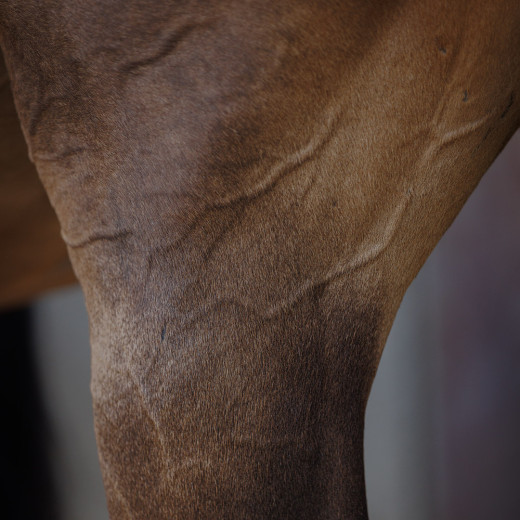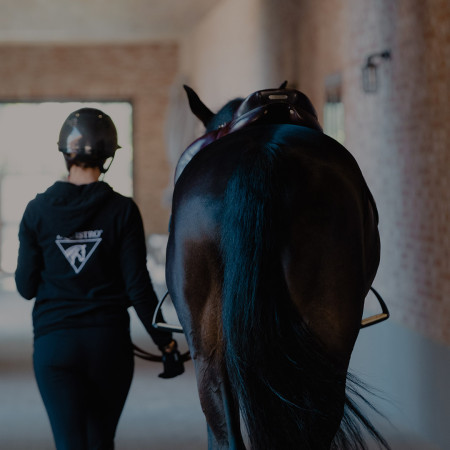
Muscle growth
Endurance and power – the musculature of the horse
In a horse the muscles account for almost 40% of total body weight. This figure highlights how important muscles are to this flight animal. But muscle strength, condition and endurance do not just depend on training and appropriate diet. The cardiovascular system, respiratory system and metabolism of a horse must also be in top condition to ensure maximum muscle performance. The oxygen needed for generating energy in the muscles must be transported in the blood from the alveoli of the lungs to the musculature in sufficient quantities and as quickly as possible. The muscles additionally require important nutrients for growth, regeneration and cell membrane protection. Should there be any shortage in the supply of oxygen or nutrients, muscles may tire faster, become over-acidified and possibly take longer to recover. In anatomical and physiological terms we distinguish between three different types of muscles:
Cardiac muscles
Cardiac muscle cannot be influenced or controlled at will. Contraction is brought about by the sinus node, the body’s own pacemaker.
Smooth muscles
These muscles are also known as organic muscles because they are found in organs of the body. They line the walls of the entire gastrointestinal tract for example and are likewise present in the blood vessel walls. This musculature cannot be controlled at will either, but is regulated by the autonomic nervous system (parasympathetic/sympathetic).
Skeletal muscles
It is these muscles that make up the horse’s locomotor system together with the bony skeleton, tendons, ligaments and fasciae of the body. The horse is able to move the skeletal muscles at will, influencing them individually as wished.
What type in which horse?
Each muscle in the horse is a combination of three different types of muscle. The secret to these muscle types is found in the muscle fibres. As in humans, we distinguish in the horse between different types of muscle fibre. Which of these three types occurs to what degree is not only influenced by genetics and gender, but also by training and diet.
• Type I
Slow twitch These endurance-type fibres contract slowly, but are characterised by consistent performance over long periods of time despite continuous load as long as they are supplied with sufficient oxygen. Horses whose muscles mainly consist of type I fibres frequently do not look very muscular but are capable of enormous feats of endurance (e.g. long-distance horses).
• Type IIa
Fast twitch These power and endurance-type fibres are capable of taking up large amounts of oxygen due to their relatively high content of myoglobin (red pigment). Consequently, although these fibres tire faster than type I fibres, they do so more slowly than those of type IIb. They typically achieve full performance for around 30 minutes and thus predominate in horses that need power as well as endurance (e.g. event horses).
• Type IIb
This type of muscle fibre contracts the fastest and most powerfully. The main sources of energy generation are ATP and anaerobic lactic acid glycolysis. Due to their metabolism these fibres contain very little myoglobin (hence their white colour) and very few mitochondria. Such fibres can only maintain their activity levels for around 60 seconds and are particularly plentiful in horses that need to develop a lot of force quickly, but merely for short periods (e.g. racing horses).
Support in building muscle – management counts
Training
The most important aspect is repeated training! Without training there can be no development of healthy muscles. When it comes to training, it is of course not just a horse’s age, nutritional status and state of health that has to be considered, but also his level of performance. Training must then be individually geared to these factors. To support the muscles in the various phases of training (muscle development, fitness/endurance training, protection from over-acidification, recovery), the addition of different feed supplements to the diet can also make a valuable contribution to ensuring optimal development and nutrient supply.
Energy
Muscle cells firstly need energy if they are to do work, i.e. to move. This is produced in the body from glucose in the form of adenosine triphosphate (ATP) with the help of oxygen. The substance required here is produced through the breakdown of long-chain carbohydrates (such as cellulose) from the food in the gastrointestinal tract. Splitting up these long chains of glucose is a laborious process, and it is often impossible for all sugar molecules contained in the cellulose to be absorbed through the mucosa of the small intestine and made available to the metabolism of the muscle cell. The supply of what are known as easily digestible carbohydrates (short-chain carbohydrates) in the form of readily digested, thermally processed starch, which can be broken down more easily into its molecular components by digestive enzymes, is a far more efficient source of energy for supporting muscle activity.
Protein
Muscle development also depends on a supply of high-quality protein to build and regenerate the filaments capable of contraction (muscle protein) of the muscle fibres. But not every feed substance offers optimal availability of the protein sources it contains. Where the total protein content of forage is too high (e.g. young grass), there is the risk that not all protein can be broken down by enzymes in the small intestine and absorbed. This results in microbial fermentation in the large intestine, possibly causing, with excessive intensity, too a change in the pH value.
In addition, excessive microbial fermentation gives rise to short-chain carbohydrates including ammonia and hydrogen sulphide, which are absorbed by the intestinal mucosa and broken down by the liver. They have to be excreted via the kidneys, possibly overburdening these organs in the long term. It is thus not the amount of protein that is critical in the diet, but the quality. Horses can absorb protein most efficiently in the form of short-chain peptides. This is because the source for developing new muscle mass is amino acids, the smallest molecular components of proteins.
The amino acids lysine and leucine play a key role here. As a first-limiting amino acid, lysine is the primary building block for muscle proteins. If this amino acid is not present in sufficient levels, it will not be possible to build muscle protein even with an excess of other proteinogenic amino acids. Leucine firstly stimulates the cells (mitochondria) to produce ATP to act as fuel and also increases the insulin sensitivity of muscle tissue after training, so ensuring fast recovery through the rapid replenishment of glycogen reserves.
Protection
Free radicals are short-lived, highly reactive molecule fragments whose release during cell respiration takes place with the generation of energy from glucose. When released, these free radicals damage important molecular components of proteins and lipids, including the cell membrane. This process is also known as oxidative stress.
Besides all cells of the body, muscle cells thus additionally include a number of antioxidant mechanisms to reduce the harmful influence of free radicals. Enzymes, antioxidants and vitamins that protect muscle from oxidative damage play a key role. To synthesise these enzymes, the organism needs selenium, which can be best absorbed in the intestine in organically bound form. The additional intake of selenium is essential for the synthesis of glutathione peroxidase, the most important antioxidantly active enzyme in the equine organism.
The fat-soluble vitamin E is also a natural antioxidant which protects cell walls from damage caused by free radicals. Competition horses require significantly higher amounts of vitamin E than those with only average levels of exercise. It has been demonstrated here that dietary supplements with vitamin E and organic selenium can increase performance of the muscles and improve their capability for recovery.
Dr. med. vet. Caroline Fritz







